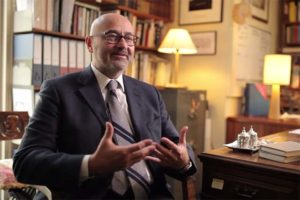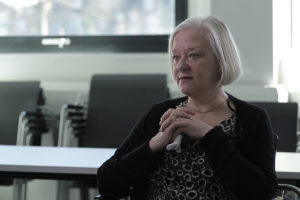Dante’s Heaven
Alessandro Scafi on Divine Comedy story line, the desire of God, and Mark Twain
Dessins d’enfants is a French phrase that means children’s drawings. It’s a theory that was developed by Grothendieck in the 1980s, and he was fascinated by the fact that very simple drawings such as the one I will show you now can encode very sophisticated mathematical information. Here is an example: this is the sort of drawing that a child might make to represent a human being. It’s sometimes called the one-armed bandit or the matchstick man.
What it represents is a Riemann surface of genus 3601, an algebraic curve defined by a polynomial of degree 12 with coefficients in a certain algebraic number field. The automorphism group of this Riemann surface is the simple group M12, the Mathieu group of order 95040.
So this very simple drawing, just a few points on lines on a sheet of paper, represents some very complicated mathematics. That was why Grothendieck gave this rather strange name, dessins d’enfants, ‘children’s drawings’ to this theory.
To explain this theory, we have to go back 160 years to Riemann. In the middle of the 19th century, Riemann introduced what we now call Riemann surfaces. These are surfaces like the sphere or the torus or surfaces of the higher genus in which, locally, you have complex coordinates. This allows you to imagine, locally at least that you are in the complex plane so you can do calculus, you can differentiate, can integrate and so on. So you can do calculus, you can do analysis, and locally, it works just as in the complex plane, but globally, depending on the shape of the surface, the answers may be rather different.
Now, because these compact Riemann surfaces can be defined by polynomial equations, it’s of interest to mathematicians to know for particular subfields of the complex numbers which Riemann surfaces can be defined over those subfields, that is, by polynomials with coefficients in those fields. For some subfields, such as real numbers, the answer is easy; for others, such as the field of rational numbers, it appears to be extremely difficult. There’s an intermediate case which concerns the field of algebraic numbers.
The algebraic numbers are those complex numbers which can be found as roots and polynomials with integer coefficients. They include all the rational numbers, some irrational numbers such as the cube root of 2, some imaginary numbers such as the square root of -1, but they do not include transcendental numbers like e or π which have to be defined using geometry or analysis. These algebraic numbers form a field, they’re closed under addition, subtraction, multiplication and division.
The question then is, which Riemann surfaces are defined using algebraic numbers? This is the question that Grothendieck was wrestling with in the early 1980s. And then he discovered that a Russian mathematician called Belyi had already answered the question in a lemma which was tucked away in a paper on a different subject, namely Galois theory. What Belyi did was show that the Riemann surfaces defined over algebraic numbers can be characterised as having a meromorphic function on them, which is branched over at most three points. That’s a very technical condition, but Grothendieck was able to reinterpret this condition to show that the Riemann surfaces defined over algebraic numbers are precisely those which can be obtained from maps on surfaces, that is, graphs drawn on surfaces like the little example I showed you.
Now, how do you obtain a Riemann surface from such a graph drawn on the surface? Every such map is a quotient of what is called the universal map: this is an infinite map drawn on the hyperbolic plane. The hyperbolic plane is a Riemann surface; it’s a subset of the complex numbers, so it has the structure of a Riemann surface, and every quotient of it therefore inherits the structure of a Riemann surface. So these quotients are themselves Riemann surfaces. In fact, they are compact Riemann surfaces, and the ones that you obtain in this way are precisely those which are defined over the field of algebraic numbers.
These little drawings give you an exact characterisation of the Riemann surfaces and the algebraic curves which Grothendieck was investigating at that time.
Already that was a remarkable result that you can describe these very complicated structures by simple drawings like that.
But he did rather more than that because Grothendieck was interested in studying what is called the absolute Galois group. This is the automorphism group of the field of algebraic numbers. It’s a very big group; in fact, it’s uncountable, so it’s certainly not finitely generated. It’s complicated; it has a topology, it’s a topological group, but it has the topology of a Cantor set, which is very pathological: it’s not smooth in any reasonable sense; it’s a very fractured group. It’s an important group because, in a certain sense, it encodes the whole theory of algebraic number fields.
So it’s very important to understand this group, but it’s a very difficult group to work with. If we can find something for this group to act on, then it will give us some insight into what this group looks like and its internal structure. These maps on surfaces give us a geometric way of seeing the internal structure of this absolute Galois group. How does that work? The absolute Galois group consists of the automorphisms of the field of algebraic numbers, so the elements of this group permute the algebraic numbers they change them around. They, therefore, can be applied to the coefficients of the polynomials defining these compact Riemann surfaces, these complex algebraic curves.
So an element of the absolute Galois group can be applied to these coefficients and it can convert one polynomial into a different polynomial. It can therefore change the algebraic curves, and therefore it can change the dessins d’enfants, the maps associated with them.
So you can see the elements of the absolute group in action by the way they transform these dessins into each other. As a very simple example, let’s go back to the example I showed you at the beginning. Complex conjugation is an element of the absolute Galois group. It’s the easiest non-identity element to see. What does it do to any dessin d’enfants? Well, it’s not difficult to guess: it acts by transforming it into its mirror image. That’s a rather trivial example, there are much more complicated examples where elements of the absolute Galois group act in a much more dramatic way, transforming one dessin into another one.
This has led to a great theory in which mathematicians have tried to elaborate the ideas put forward by Grothendieck. Grothendieck wrote a great set of notes, ‘Esquisse d’un Programme’ (Sketch of a program), in 1984 and then more or less gave up mathematics. He lived the last few decades of his life as a hermit in the Pyrenees with almost minimal contact with the rest of the world. He died a few years ago, but he left us this great body of work full of conjectures and ideas, and in the decades since then, mathematicians have been filling in the details of Grothendieck’s theory. There’s still a long way to go; we don’t understand the orbits of the absolute Galois group, and we can’t determine whether two dessins are equivalent under the absolute Galois group, but we’re working on it, so there’s plenty more work to do.

Alessandro Scafi on Divine Comedy story line, the desire of God, and Mark Twain

Psychologist Pamela Heaton on the areas of strength in children with Williams syndrome, how do they recognise ...

Neuroscientist Karl Friston on the Markov blanket, Bayesian model evidence, and different global brain theorie...